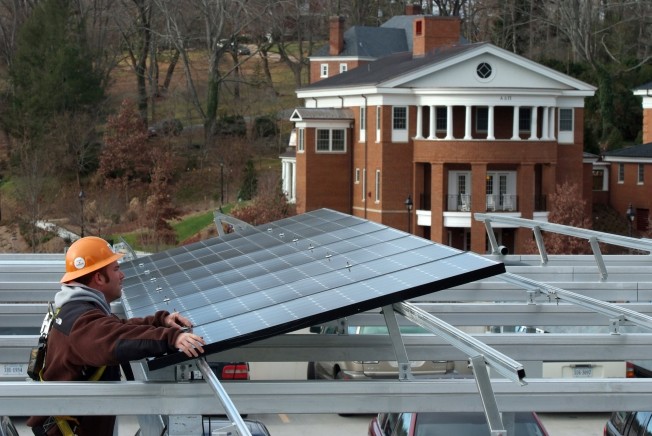
A worker installs solar panels at Washington & Lee University. Photo courtesy of Secure Futures LLC.
In June, Fairfax County announced it was seeking proposals from solar companies to install solar at up to 130 county-owned facilities and schools, with another 100 sites to be considered for a later round. The request for proposals (RFP) covers solar on building roofs, ground-mounted solar and solar canopies over parking lots.
This massive solar buy could add as much as 30-40 megawatts of solar, according to one industry member’s calculation. This would easily triple the amount of solar installed to date in the entire NoVa region. What’s more, Fairfax County’s contract will be “rideable” so that other Virginia localities can install solar using the same prices and terms.
“It’s hard to overstate how significant a move this is,” says Debra Jacobson, an energy lawyer who serves on the county’s Environmental Quality Advisory Council. “It’s not just the largest solar buy by a local government in Virginia. It also opens the door for other Virginia counties and cities to buy solar because it makes the process simple and straightforward.”
Jacobson says approximately 15 solar companies attended a bidder’s conference hosted by Fairfax County, indicating strong interest. The county intends to select a contractor by early fall.
One problem stands in the way: Virginia law currently places an overall limit of 50 MW on projects installed in Dominion territory using third-party power purchase agreements (PPAs), the primary financing mechanism for tax-exempt entities.
Even without Fairfax County’s projects, the solar industry warns the cap will likely be met by the end of this year, as schools, universities, churches and other customers across Virginia sign PPAs at an accelerating rate.
The solar industry is asking the State Corporation Commission for action to keep the market alive. Secure Futures LLC, a Staunton-based solar developer, submitted a letter to the SCC on June 24 asking the commission to raise the program cap from 50 MW to 500 MW in Dominion territory and 7 to 30 MW in Appalachian Power territory and to increase the size limit for individual projects from 1 MW to 3 MW.
PPAs allow customers to have on-site solar installed with no upfront cost; the customer pays only for the electricity the solar array produces, at a price that is typically below the price of electricity purchased from the utility. It’s an especially critical tool for cash-strapped local governments and school systems, letting them save taxpayer money while lowering their carbon footprint. Every kilowatt-hour they get from solar replaces electricity they would have to buy from the grid, which in Virginia still comes almost entirely from fossil fuels and nuclear.
For-profit monopoly utilities like Dominion Energy Virginia and Appalachian Power don’t like losing sales when customers generate their own electricity. Virginia’s customer-owned electric cooperatives negotiated legislation this year to remove PPA barriers for non-profits in their territories, but Dominion and APCo didn’t sign on. Both utilities fought Solar Freedom legislation and other bills that would have lifted the PPA cap, claiming there was still plenty of room for projects under the 50 MW cap.
But there may be a simple solution — if the utilities don’t fight it. The legislation that created the PPA program in 2013 directs the SCC to review it every two years beginning in 2015, and to “determine whether the limitations [on the program size and project sizes] should be expanded, reduced, or continued.”
The SCC has never opened a case docket or consulted stakeholders in any previous review of the program — but no one seems to have asked until now. Secure Futures’ letter requests that the SCC open a public docket for this year’s review and consult with stakeholders, including the solar industry and customers.
In his letter, Secure Futures’ CEO Tony Smith notes that Virginia remains well behind North Carolina and Maryland on solar installations, solely for reasons of state policy. Installations using PPAs also lagged until the past year, but are now expanding “at an exponential rate,” according to Secure Futures, with notifications filed for almost 20 MW of projects as of June 12. This number does not include the Fairfax County projects or many others that are still in the early stages of development.
Other solar developers have also asked the SCC to lift the PPA cap. Ruth Amundsen, manager of the Norfolk Solar Qualified Opportunity Zone Fund, told the SCC in a July 20 letter that her fund has identified $117 million of potential solar sites in the Norfolk and Virginia Beach area. The fund brings in investors and installs solar on businesses and non-profits in Virginia Qualified Opportunity Zones, which are low income census tracts that offer tax benefits for investors, at no upfront cost to the customer. It also hires residents of the Opportunity Zones as solar installers, training them and providing employment.
But, Amundsen’s letter notes, “Without PPAs, none of this is possible. If the PPA cap remains at 50MW, we cannot in good conscience advise these investors to invest in solar in the Virginia QOZs, as there would be no feasible financing method once the cap is reached.”
Amundsen also wants the ability to use PPAs for installation on private homes, which is currently not allowed under the terms of the PPA program in Dominion territory. “The original intent of the Norfolk Solar QOZ Fund was to mitigate the energy burden of low-income home owners. But because of the current limitation on Power Purchase Agreements (PPAs) in Virginia, we cannot install on private homes via a PPA. Removal of that limitation, and clarification that PPAs are legal with all customers, would allow us to better serve the most affected residents as far as crushing utility bills.”
This article originally appeared in the Virginia Mercury on August 1, 2019.
